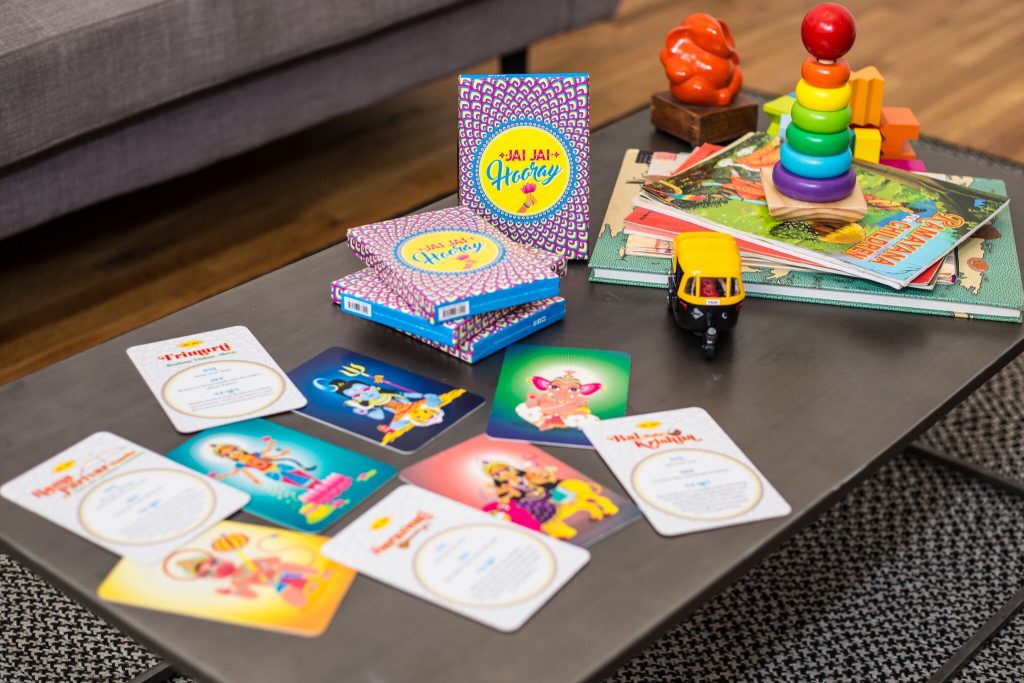
by Runway&Rattles – Follow @sheenad29
There is no better joy than finding new and exciting tools in the market that teach our kids more about our South Asian culture and religion. We do what we can on our own—take them to temple occasionally, celebrate Hindu holidays, recite prayers to them daily, at home-cooked food and speak the language. But sometimes, we feel like the kids just go through the motions because we want them to, however, many of them don’t stop to understand who they are praying to or what the story behind each deity is.
Insert Jai Jai Hooray. We recently fell in love with Jai Jai Hooray’s new 10-set flashcard collection and couldn’t be happier to share our experience with our friends at Brown Girl Magazine. Of course, each group of children reacted so differently, being in different age groups and growing up with different ways of learning from their parents. Overall, it was beautiful to witness what they all had to say about the cards and the sort of conversations that followed.
Jai Jai Hooray’s flashcards are a set of 9 religious deities in the Hindu religion. Each card has a vibrant, kid-friendly picture on one side, which is an immediate attention grabber in and of itself. The back of the card consists of the SAY-SEE-LEARN framework, which enables anyone to be a teacher or student. The cards come with a special intent to help the child engage and learn more about their religion and the background of the Gods that they see and pray to regularly.
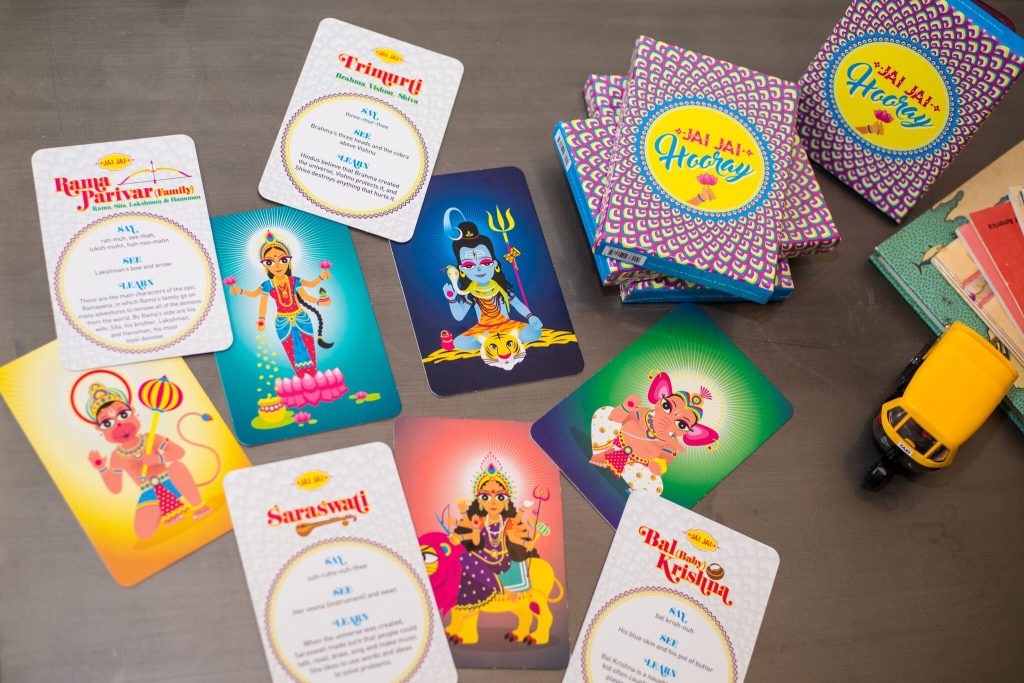 [Photo Credit: Pooja Dhar of PR Photography]
[Photo Credit: Pooja Dhar of PR Photography]
If you ask us, these cards are a no-brainer – they’re affordable ($15), durable, and enjoyable for all ages. Purchase a set of your own here and watch your kids flourish with every passing card.
SHAAN, SHAILIN, SAIYAN
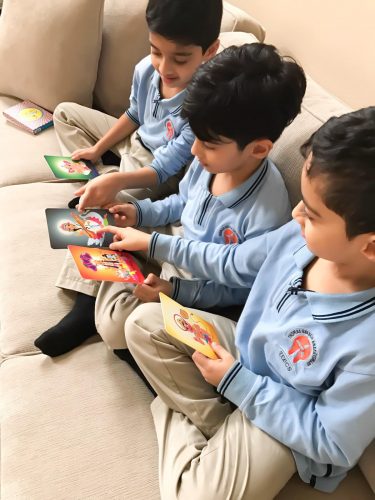
One of the harder things Sheena experiences with raising her boys in this generation is their lack of religious knowledge. She is always looking for something they (and she) can relate to when teaching them whatever she can. Growing up, Mommy Vaid was constantly teaching us as much as she could about our religion, deities, Indian traditions, and Hindu prayers. She very much wanted us to know as much as we could—even if she wasn’t directly teaching us, she made sure we were picking it up in the background. She made us sit with her during morning prayers, asked us to repeat after her, and as we got older, encouraged us to do the pujas we listened to her do.
Back then it was easier to learn and focus because we didn’t have iPads, cell phones and laptops to run back to so we sat with mom patiently as she tried to impart our culture on us. Luckily enough, Sheena’s in-laws and parents have been able to pass some of that knowledge on to their kids as well. Even with all of their help, she still feels it’s up to her to expose the boys to our religion and culture with current methods that will be able to hold their attention. She tries to teach them both the Jain and Hindu religions so they value both equally.
Hindu Deities: SAY
As for the Jain Gods, the boys attend school at their local temple and learn a lot about the Jain religion, their traditions, and the unique stories of the deities. She loves how intrigued they are by everything they learn there. As for the Hindu Gods, she doesn’t find herself as qualified to teach them on her own, so she depends on activities like these Jai Jai Hooray flashcards, books and her mom for the exposure.
The flashcards were a hit with the boys—they loved learning about the many Hindu Gods, what they stand for, who they can relate them to, and create their own version in their minds to remember who is who. They knew most of them by name as they are all in their home temple, but they enjoyed practicing the pronunciations and putting a familiar face to the name.
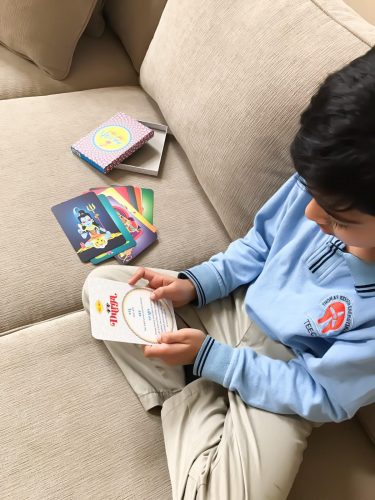
Hindu Deities: SEE
Sheena’s boys are VERY visual, whether it be books, cards, TV or computer screens. They learn more from the visual and not the verbal, and that’s why they loved these cards so much. The bright colors, detailed pictures, and huge variety caught their attention instantly (which is already a hard task in itself)! They were able to relate the pictures of the different Gods to the statues they see in our home temple. It was a true pleasure for Sheena to see how much they already knew and how excited they were to learn more. They loved showing each other the “cool” parts of the pictures as well.
If they saw an image they didn’t recognize, they would ask Sheena if this God was in their temple and that immense interest made the cards an instant hit for Sheena.
Hindu Deities: LEARN
Now that all three boys are reading fluently, Sheena absolutely loved hearing them read the descriptions to her out loud. It insured to her that they were actually reading (and not just skimming) the cards and understanding what each one said. She loved that they would summarize each card after reading it and sometimes even come up with their own version of the description. Their imagination was running wild with 1000 questions for mommy after each card (and she tried her very best to answer all of them). She loved that they showed that much interest and already sees them reading them again to remind themselves of what they learned. She also felt that the number of cards was perfect as any more would have lost their interest and at least one of them would have left the group conversation before the end. They all not only stuck around to go through all the cards but truly enjoyed learning through them!
NAYA, NIVA, NESA
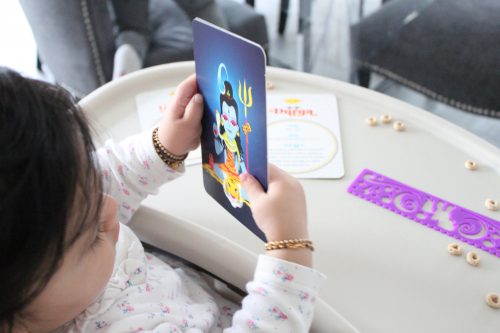
Nina has tried to find ways to teach the girls about “jai jai” in different ways other than preaching. She tries to have them sit in front of their small temple at home for just a few minutes a day and sing a song or two if they can concentrate that long in their morning excitement. Nina had taught the girls the names of all the Gods in their home temple, but never really explained the role of each one. So the arrival of these cards was literally just what she needed. And the girls loved the Jai Jai Hooray cards instantly!
Hindu Deities: Say
Naya immediately started trying to pronounce the names of all the deities after looking at their pictures. She was able to use the phonetic pronunciation on the back of the card to say each one just right. This really made her proud—as Nina shouted, “THAT’S RIGHT!” It was probably one of the first times they were saying the names properly without mommy having to correct them. Naya tried to read all the words on each card and because the language is simple, it was achievable for her, which made her and mommy both pretty proud. Niva was not so much into the saying part. She turned the cards over to see the names at the top, and then immediately went back to the pictures. She was more infatuated with the images on the front of the card. Nesa showed her excitement the only way she knows how—plenty of squeals admiring the pictures.
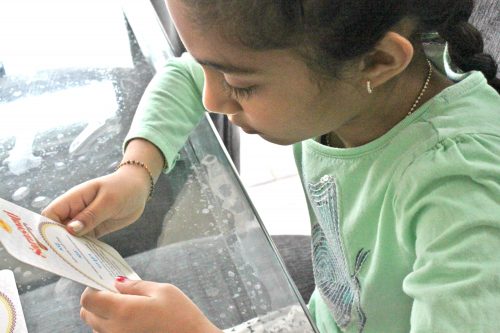
Hindu Deities: See
Naya pointed out several cards and asked things like, “Why is he sitting on a lion?” and “Why is he a monkey?” She was captivated by the colors and the imagery. Nesa was enamored with the cards and just kept turning them round and round in awe of the colors. It was very heartwarming to see her little baby light up when looking at the cards. Nina loved the visuals themselves propelled the girls into asking more questions than they would have to see the images in a book. They liked holding their own card and learning everything about the God they were holding. The fact that the illustrations are geared towards children made them appealing to the age group and kept them interested, which is a very tough task these days!
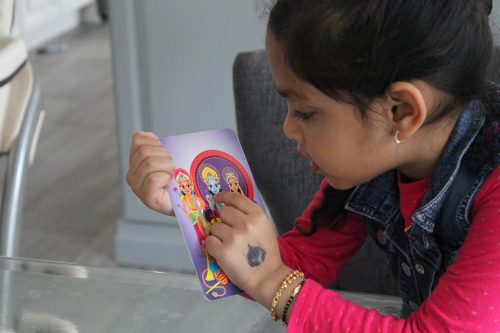
Hindu Deities: Learn
What a great tool to getting these girls into learning more details about the different Hindu gods. Naya and Niva intently listened to what each God’s purpose was and Naya was quick to ask questions like “What is a loyal devotee?” This expanded the conversation into what it means to be loyal and what it means to be a devotee. Each question led to more conversation about topics that the family rarely gets to talk about. The girls and Nina talked about overcoming obstacles and how some Gods help to make sure we do well in school and other Gods help bring prosperity to the family. The explanations on the cards are really basic and touch to the essence of the belief of God, allowing the kids to really explore and take the conversation in whatever direction they please.
This box set is really very well done and Nina felt that it was a great tool in getting the girls engaged in the world of Hindu Gods. The girls asked if they could place the cards in our temple at home and Nina immediately fell in love with that idea. What a lovely gesture to be able to say, let us pick up that card and remind ourselves who we are praying to.
DIAV
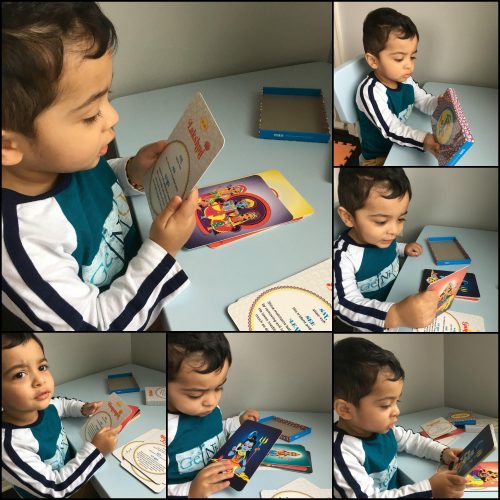
Hindu Deities: Say
Diav has grown up with Dipti and Sachin showing him flashcards all day, every day. They knew from early on that Diav picked up on this method really well and so took advantage and taught him everything he knows in flashcard form. He is also very big into singing and knows tons of religious songs that his grandparents have taught him through his two years. Diav absolutely loved going through the Jai Jai Hooray flashcards! He’s familiar with most of their names as they’ve come up with songs here and there, but more than anything else, he loved pointing to the familiar objects on the cards and screaming “elephant is Ganesh” and “Hanuman is the monkey!” When he came upon an unfamiliar face, he waited for mommy to give him a hint, “who holds all the coins?” and excitedly screamed “Laxmi!”
Hindu Deities: See
The colorful box itself was enough to grab’s Diav’s attention! He took one look and couldn’t wait to open it up and see what was inside! And when he did, he couldn’t be more thrilled with the pictures! He loved that the cards had one familiar aspect to it, whether it was a mouse or a snake, he knew something on each card. This made it easy for him to associate the familiar items with the name of the God that mommy was telling him. He knew that Ganesh is an elephant and that Durga sits on a lion! The vibrant colors immediately captivated him and he ended up staring at most of the pictures for some time!
Hindu Deities: Learn
Being two years old, the learning part was slightly advanced for Diav. Dipti read all the learning parts to him but he was more interested in the picture and practicing the words than he was with the story that each card had attached to it. For him, it was about looking at the picture, finding the animal and associating the animal with the God. While he didn’t appreciate the learning part as much, his daddy and mommy were so into it! Dipti is Hindu while Sachin is Jain so they rarely talk about the back stories of their respective religions (they both also don’t know THAT much about them). But both loved reading the “learning” portion of the cards as it helped them understand the story behind the Gods that they pay their respects to every day! They were surprised with how much they didn’t know and appreciated that the cards kept it short and simple for the entire family.
Diav is so fond of the cards and now his new morning and evening routines include going through the Jai Jai cards.
Help your kids discover the exciting world Hindu Gods and Goddesses through these amazingly handcrafted Jai Jai Hooray flashcards! We assure you, you won’t be disappointed.
The following sponsored product review is written by the sisters and founders of Runways & Rattles, Dipti Vaid Dedhia, Nina Raoji, and Sheena Dedhia. Each one shares an honest recount of how their children reacted to the set of 10 Jai Jai Hooray flashcards, which improve cultural learning. Photos are courtesy of the sisters.
 Jai Jai Hooray is the first product of Umani Studio, founded by Rupa Parekh. Her mission is to create beautifully simple cultural learning tools that introduce India to new audiences with a modern flavor. Discover her first tool—Jai Jai Hooray mythology flashcards, illustrated by India-based artist, Ajinkya Bane. The SAY-SEE-LEARN framework enables anyone to be a teacher or student. Inside the handcrafted box, comes nine deities and one “design your own” character card.
Jai Jai Hooray is the first product of Umani Studio, founded by Rupa Parekh. Her mission is to create beautifully simple cultural learning tools that introduce India to new audiences with a modern flavor. Discover her first tool—Jai Jai Hooray mythology flashcards, illustrated by India-based artist, Ajinkya Bane. The SAY-SEE-LEARN framework enables anyone to be a teacher or student. Inside the handcrafted box, comes nine deities and one “design your own” character card.




